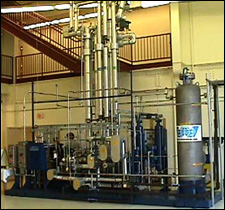Issued on: December 11, 2000
DOE-Sponsored Process Improves Use of Landfill Gas, Enhances Air Quality
Abraham Commends Small Business for Innovative Concept Being Showcased Today in New Jersey
Columbus, New Jersey - Acrion Technologies Inc., a small business sponsored by the U.S. Department of Energy, is showcasing a method this week that could offer a major advancement in reducing pollution at municipal landfills where Americans deposit more than 100 million tons of garbage every year.

|

|

|
Acrion's demonstration CO2 wash skid treats 140,000 standard cubic feet of raw landfill gas per day to produce 1 ton of commercial liquid CO2 and 70 million Btu of fuel cell grade methane. |
The garbage creates a major source of air emissions, expelling carbon dioxide (CO2) and methane as it decomposes. At an open house today at the New Jersey EcoComplex, Acrion is demonstrating how its innovation will make it easier to capture the CO2 before it escapes into the atmosphere and to use the captured gases for commercial ventures, making such "landfill gas-to-energy" projects more environmentally and economically attractive.
"Acrion took a good idea and, in partnership with the federal government, made it work," said Secretary of Energy Spencer Abraham in congratulating the company. "It will be creative ideas like this one that will be key to improving the quality of our environment and combating the threat of climate change. The Department of Energy is pleased to have had a role in fostering the development of this technology and helping it evolve to the threshold of commercial reality."
Acrion, based in Cleveland, Ohio, received a small business innovation research grant from the Energy Department in 1998. With the federal backing, the company developed a process called "CO2 Wash" which it initially tested at a New York site.
Now, with follow-on funding from the department's National Energy Technology Laboratory, the company has scaled up the process at the New Jersey EcoComplex. Acrion's first step to commercialize the innovation will be seen at an open house today where visitors touring the EcoComplex will have an opportunity to see and ask questions about the Acrion CO2 Wash system.
Since it began operating this summer, the system has been processing gases captured from decomposing waste at the Burlington County landfill. After moisture is removed, the gases are compressed and fed into the bottom of the unit's three-story high column. As the gases drift upward, refrigeration at the top of the column condenses the CO2 into liquid form. A portion of the liquid CO2 washes down the column, cleansing volatile organic contaminants from the gas.
Clean, high-grade fuel gas exits the top and can be used directly in turbines, boilers or fuel cells to generate electricity. Methane produced from Acrion's CO2 Wash is 2 to 3 times cleaner than required by fuel cells which can convert the hydrogen-rich gas into electricity without using combustion. The landfill gas could also be further processed into methanol or upgraded to pipeline specifications, depending on local market needs.
The small stream of contaminant-laden CO2 that is used to wash out impurities in the landfill gas is vaporized and burned in a flare to destroy the volatile organic compounds.
The CO2 not used for the wash is drawn off as a 99.99 percent pure liquid CO2 stream that can be used in a variety of commercial applications, from making dry ice to carbonating soft drinks. One option Acrion is examining is to pipe the CO2 to Burlington County's R&D Greenhouse and Resource Recovery Complex, where "Jersey Fresh" tomatoes and other plants would benefit from the CO2-enriched environment. Acrion is also providing samples of the pure liquid CO2 to distributors and consumers for analysis and testing in commercial applications.
Acrion's innovation is expected to add to the growing interest in using landfill gas as a renewable energy resource. Current federal law requires many landfills to collect the gas and dispose of it in one of two ways: either flare the gas, or install a "landfill gas-to-energy" system.
According to the Environmental Protection Agency, every 1 million tons of waste deposited in landfills produces enough landfill gas to generate 7 million kilowatt hours of electricity per year, enough for 700 homes. Using this gas for energy purposes, rather than expelling it into the atmosphere, is equivalent to removing more than 6,000 cars from the road, or planting 8,300 acres of trees.
- End of Techline -
For more information, contact:
News Media - Drew Malcomb, DOE Office of Public Affairs, (202) 586-5806
Technical Community - Charles Byrer, DOE National Energy Technology Laboratory, (304) 285-4547, cbyrer@netl.doe.gov
General Public - Robert Porter, DOE Office of Fossil Energy, (202) 586-6503, robert.porter@hq.doe.gov
Acrion Technologies: Bill Brown, (216) 573-1187
|